[AR] TimeSFormer: Is Space-Time Attention All You Need for Video Understanding?
[AR] TimeSFormer: Is Space-Time Attention All You Need for Video Understanding?
- paper: https://arxiv.org/pdf/2102.05095.pdf
- github: https://github.com/facebookresearch/TimeSformer
- ICLR 2021 accpeted (인용수: 1545회, ‘24-03-19 기준)
- downstream task: Video Classification (Action Recognition)
1. Motivation
-
기존에 video classification에서 SOTA는 3D-Convolution기반으로 되어 있음 (ex. Slow-Fast)
- 하지만 CNN은 근본적으로 Global 영역을 보는데 한계가 있음 (shared weights)
- 이런 한계점은 long-range dependency를 catching해야 하는 video classification에 적은 정보만 제공하게됨
-
NLP의 혁신적 성능 향상을 이끈 Self-Attention기반의 Transformer를 (그와 유사한 task인) video classification에 적용해보면 여러가지 이점이 있음
- 단어 (프레임)간의 관계를 학습하기 용이하여 long-range dependency를 catching할 수 있음
- 현대 GPU hardward acceleration에 3D Conv보다 효율적이라고 함
$\to$ Self-Attention만 가지고 Video Attention을 해보자!
2. Contribution
- Self-Attention의 이점은 살리고, 단점을 보완한 TimeSFormer를 제안함
- 단점: 모든 Spatial-Temporal patch간의 similarity를 계산하게 되어, 비효율적인 계산량이 요구되는 문제
- 해결책: spatial-temporal “divided attention”을 적용하여 위 문제를 해결함
- 장점: long-range modeling이 가능하며, 학습이 (3D-Conv보다) 빠르고, 성능이 향상됨
- Video Recongition benchmark에서 SOTA
3. TimeSFormer (Time-Space Transformer)
-
preliminaries
-
input : $X \in \mathbb{R}^{H \times W \times 3 \times F}$
- F: # of frames per clip
-
decomposition to patches : $P \times P$
- $N=HW/P^2$: # of patches per frame
-
flatten patches $x_{(p,t)} \in \mathbb{R}^{3P^2}$
- p: patch index
- t: frame index
-
linear embedding : patch $x_{(p,t)} \to z_{(p,t)}^{(0)}$로 mapping

- E : learnable matirx $\in \mathbb{R}^{D \times 3P^2}$
- e: learnable positional embedding $\in \mathbb{R}^{D }$
- z: embedding of classification token
-
query, key, value
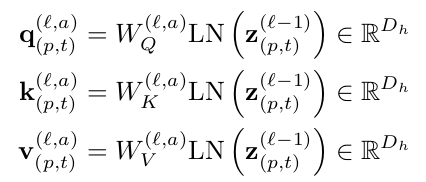
- $D_h=D/A$
- A: # of heads
- L: # of blocks
- a = (1,..,A) / p=(1, …, N) / t = (1, …, F) / l = (1, …, L)
- $D_h=D/A$
-
Self-attention computation

- SM: softmax function
- $a_{(l,a)}^{(l,a)}$: l번째 block의 a번째 head의 p번째 patch의 t번째 frame의 attention weight
- ViT처럼 classification token $z_{(0,0)}^{(l,a)}$를 붙임
-
-
Encoding
-
Residual Connection과 LayerNorm, 그리고 MLP로 구성


-
-
Classification Embedding

-
Space-Time Self-Attention Module의 여러 Variations

-
Attention 하고자 하는 neighbors
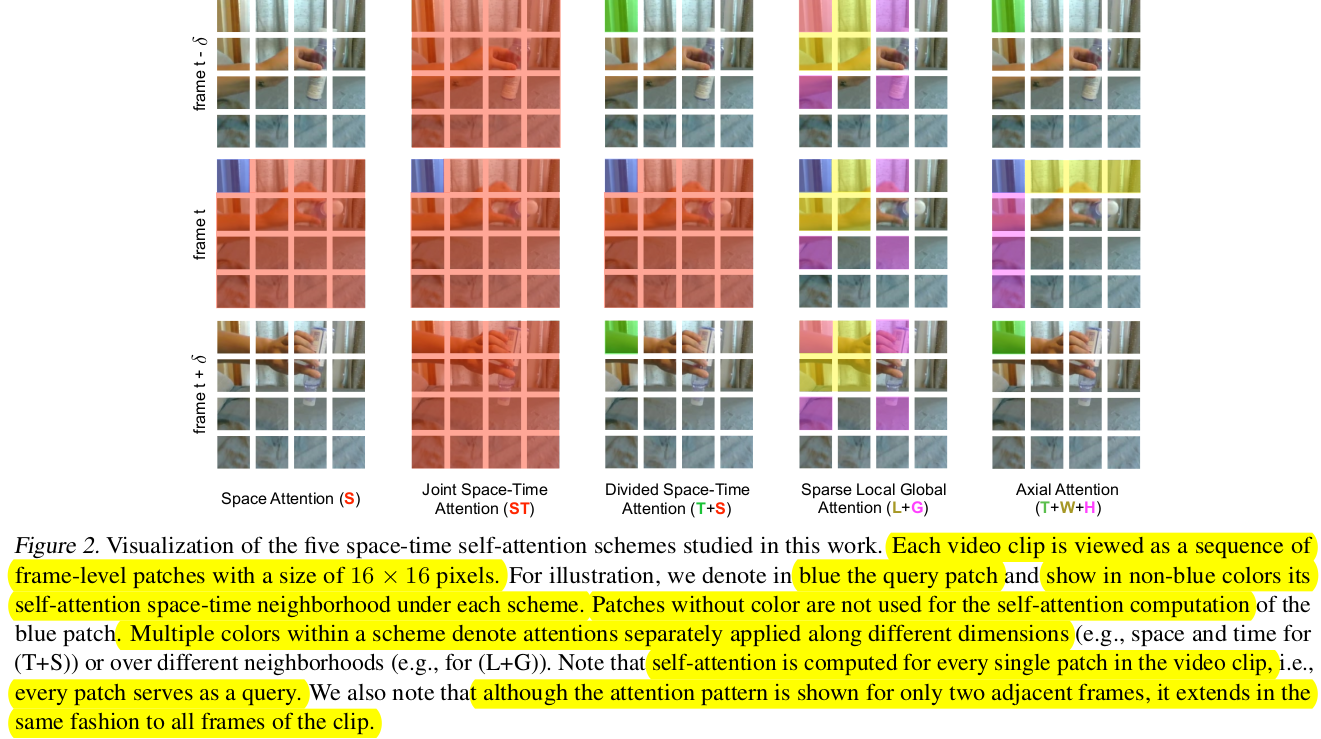
- 실험적으로 성능&속도가 제일 좋은 T+S를 사용
4. Experiments
4.1. Dataset
-
Kinetics-400

- 400개의 human action class로 구성된 video action dataset
- 각 class당 최소 400개의 clip으로 구성
- 각 clip당 약 10초 영상으로 Youtube에서 취득
- human-focused, human-object oriented interactions로 이루어짐 (ex. shaking-hands)
-
Something-Something-V2
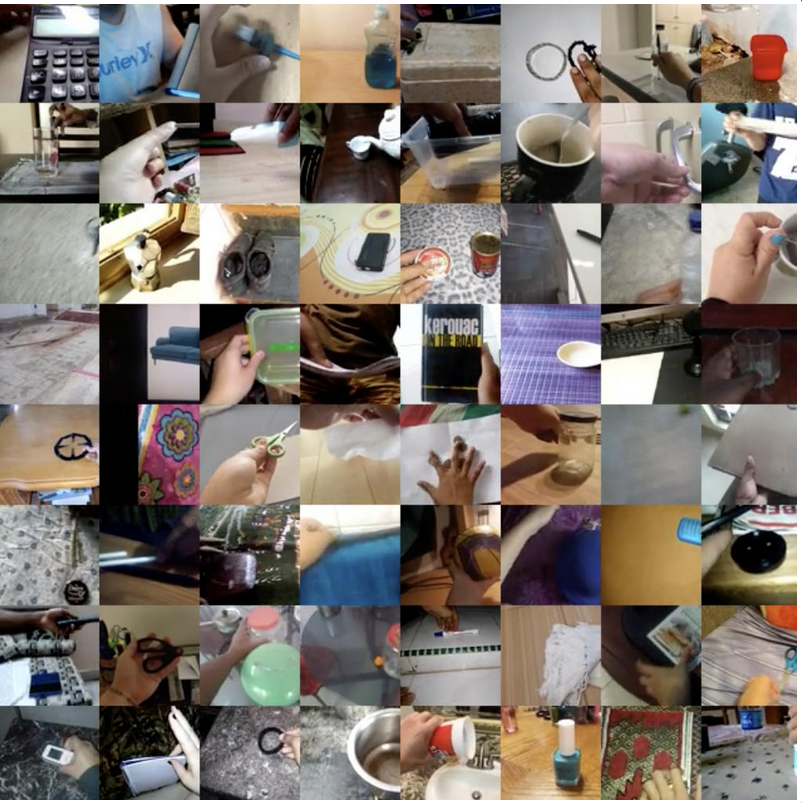
-
174개의 basic actions in real-world로 구성된 human basic actions
-
ex.
Putting something on a surface Moving something up
Covering something with something Pushing something from left to right Moving something down …
-
-
Train: 168,913 / validation: 24,777 / test: 27,157개의 clip (fine-grained)
-
-
Diving-48
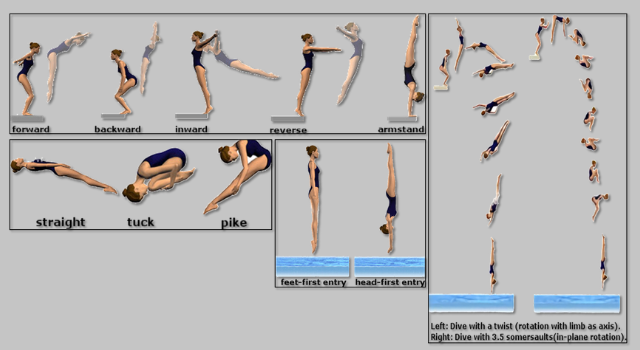
-
48개의 diving sequence로 구성된 fine-grained video dataset
-
class: take-off, landing, flight, entry $\to$4가지 기본 동작을 응용하는 세부 동작들로 이루어짐
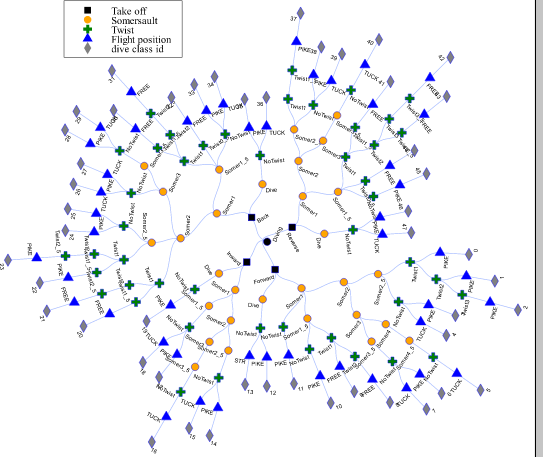
-
long-term dynamic을 이해해야하는 task
-
-
18K dataset으로 구성
-
- Input & evaluation
- clip size : 8x224x224 (8개 frame)
- sampling rate : 1/32
- 3 spatial crop (top-left, center, botton-right)의 평균 score
- Computational Cost vs. Parameters
| parameters vs. accuarcy | TFLOPS vs. resolution or #of frames |
|---|---|
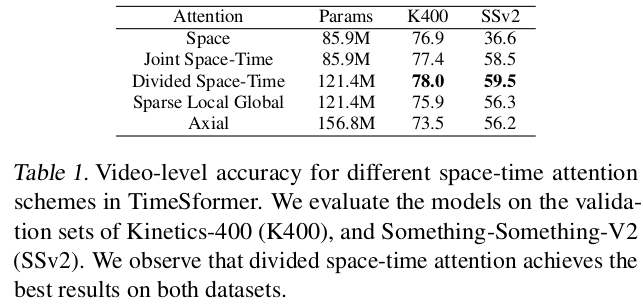 |
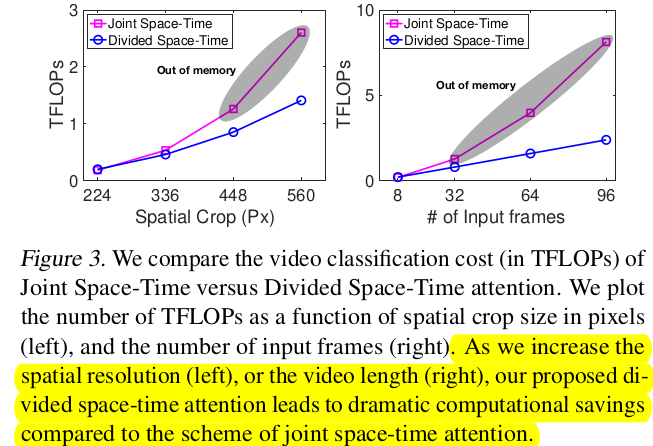 |
-
Comparison to 3D CNNS
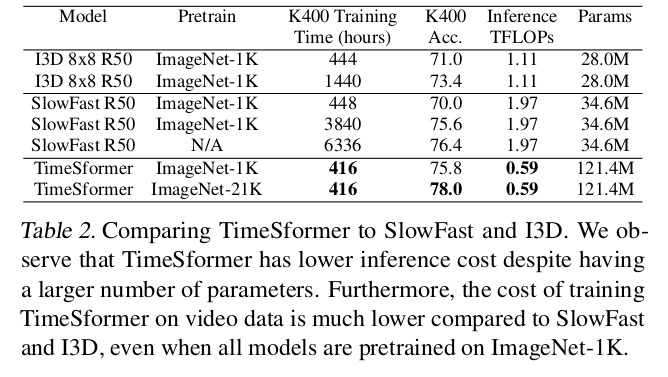
-
Model Capacity (#of parameters)가 TimeSformer가 더 많음
-
하지만 inference TFLOPS가 적고, training / inference time도 훨씬 적음
-
20K video evaluation inference time
-
14.88h (3D CNN) vs. 36minute (TimeSformer)

-
-
-
-
Importance of pretraining
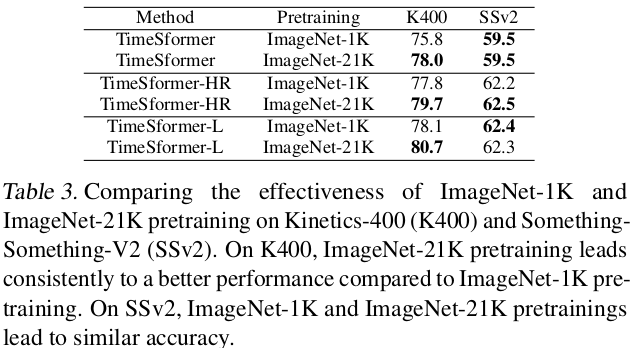
-
K400은 spatial scene information에 biased되어 있어, Image-based Pretrain에 영향을 많이 받음
-
SSv2는 “temporally-heavy”한 특성이 있으므로, frame간 관계가 학습성능에 더 민감하므로 Pretrain에 영향을 덜 받음
-
ImageNet-21K > ImageNet-1K > Scratch (64.8%@K400)
TimeSFormer TimeSformer-HR TimeSFormer-L 8x224x224 16x448x448 96x224x224
-
-
Impact of Video-Data Scale
{25%, 50%, 75%, 100%}로 학습에 사용하는 데이터를 scaling
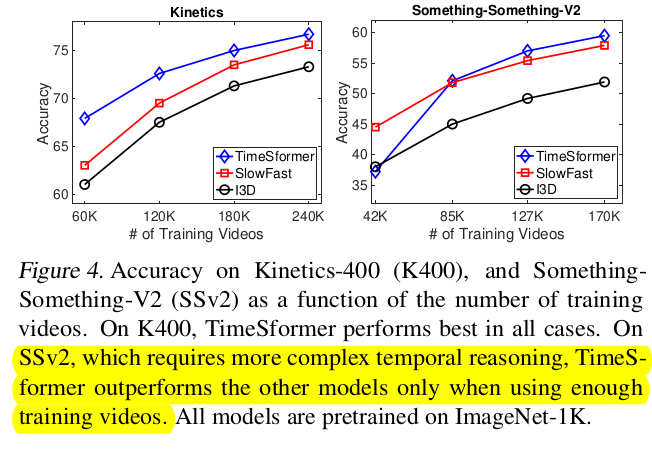
- SSv2는 3D-Conv기반 SlowFast가 데이터가 적은 경우 성능이 좋음
- 이는 inductive bias때문.
- SSv2는 temporal 관계를 학습하기 상대적으로 더 복잡한 데이터이므로, 많은 데이터가 요구됨
- SSv2는 3D-Conv기반 SlowFast가 데이터가 적은 경우 성능이 좋음
-
Varying # of tokens

- higher resoultion
- longer videos
-
Importance of positional embedding

- Space-Only에서 K400은 좋은 성능을 냄 $\to$ spatial biased
- SSv2는 Space-Time모두 넣어야 좋은 성능 $\to$ temporal heavy
-
VS SOTA
|
 |
|  |
| —————————————————– | —————————————————– |
|
| —————————————————– | —————————————————– |
| 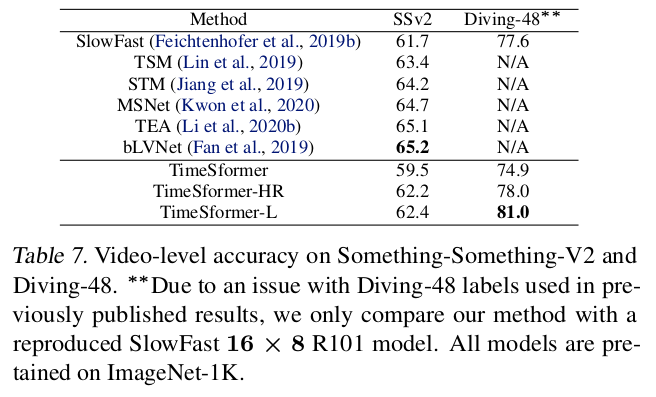 |
| 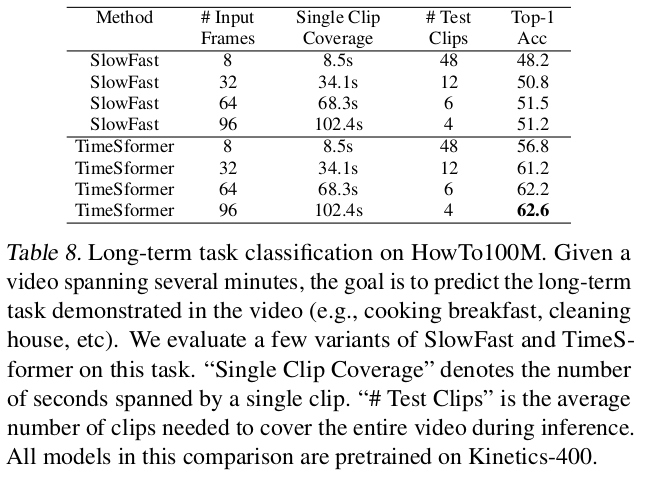 |
| —————————————————– | —————————————————– |
|
| —————————————————– | —————————————————– |
-
Number of clips used for validation

- previous 방식들은 10 temporal clips with 3 staial crops (30 space-time views)를 가지고 판단했다고 함
- TimeSFormer는 1개 clip로 좋은 성능을
-
Visualization
-
Attention Rollout scheme (CAM같은)
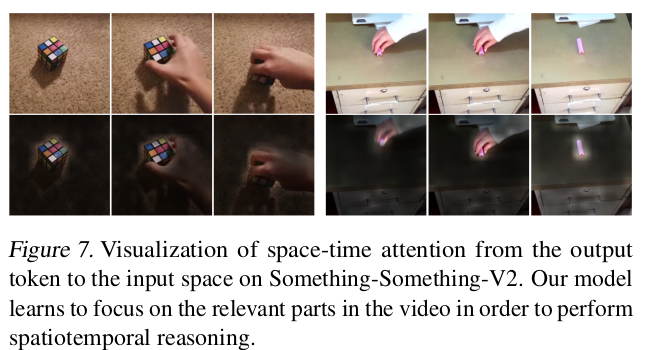
-
t-SNE
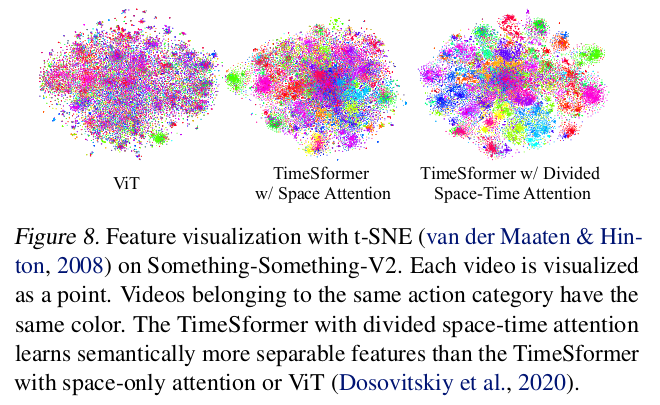
-